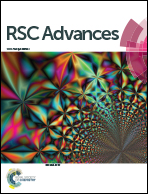Wide visible-range fluorescence of Eu3+ located in the macroscopic bi-layer ceramic/glass composite
Abstract
The Eu3+ doped fluoride bi-layer ceramic/glass composite (GCZBL-Eu) was prepared by a one-step method and the effective wide visible-range fluorescence was recorded. The de-population rates of the 5D0, 5D1, 5D2, and 5D3 multi-levels in the glass layer (GZBL-Eu) were estimated to be 214, 746, 1163, and 680 s−1, respectively, and that in the ceramic layer (CZBL-Eu) were 211, 730, 1075, and 654 s−1, which implies multi-channel radiative transitions due to the non-radiative relaxation limitation of low OH content and low phonon energy. Simultaneously, the quantum efficiencies of the 5D0 levels in GZBL-Eu and CZBL-Eu were as high as 98.5% and 94.8%, respectively, thus demonstrating the effectiveness of the radiative transition emissions from Eu3+. Besides, GCZBL-Eu with the glass forming layer increases the emission intensity by 24% compared to CZBL-Eu, which is attributed to the multiple-cycle reflection in the composite structure of the glass–ceramic transition region, and the color coordinates of CZBL-Eu (0.483, 0.385) and GCZBL-Eu (0.469, 0.389) show that they can release yellowish-white light. The hetero-structured GCZBL-Eu provides a new approach for laser lighting, fluorescent display, and up-conversion applications.



 Please wait while we load your content...
Please wait while we load your content...